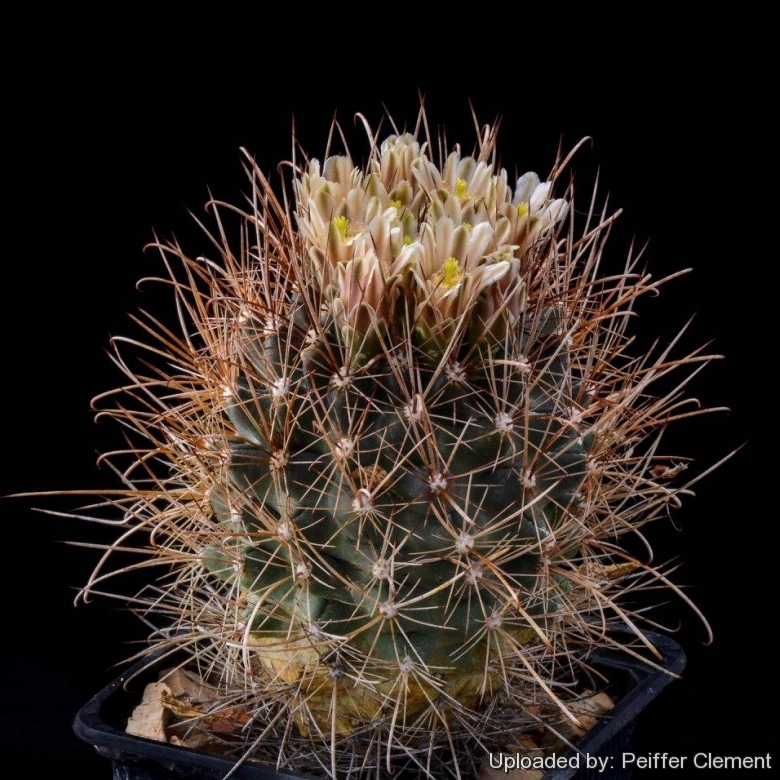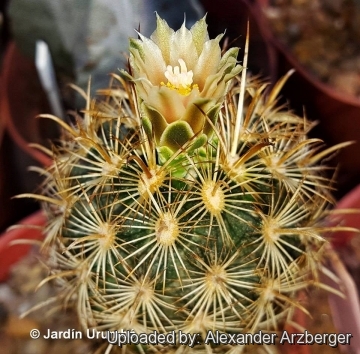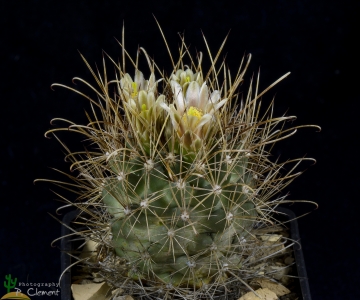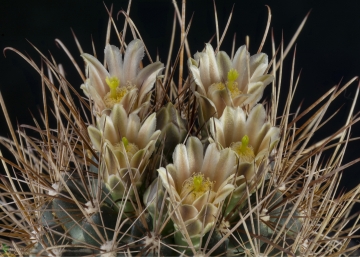
Sclerocactus brevihamatus Photo by: Peiffer Clement
Origin and Habitat: USA, Southern Texas (Edwards Plateau of Texas in Bandera, Edwards, Kerr, Kimble, Kinney, Real, Uvalde, and Val Verde counties)
Altitude: 300-1300 m asl.
Habitat: It grows in gravelly plains, rock hilltop and floodplains in open areas with only grass cover and scattered oak and juniper, often somewhat protected by rocks. The soil is shallow, gravelly and clayey often on limestone sediments and slightly alkaline. Other commonly associated plant species in the habitat include Coryphantha sulcataSN|10068]]SN|10068]], Juniperus ashei, Diospyros texana, Quercus fusiformis, Opuntia engelmanniiSN|19920]]SN|19920]] var. lindheimeri, Mammillaria heyderiSN|20805]]SN|20805]], Aristida purpurea and Pinus remota.
Synonyms:
See all synonyms of Sclerocactus brevihamatus
Common Names include:
ENGLISH: Short-hook fishhook cactus, Spine cactus
Description: Sclerocactus brevihamatusSN|25266]]SN|25266]] is a small deep-seated cactus that live 10 or more years, but large individuals might be at least 50 years old. The plant is usually solitary and relatively similar above ground to the related Sclerocactus brevihamatusSN|25266]]SN|25266]] aubsp. tobuschii, but the Tobusch fishhook cactus has hooked spines.
Roots: Short central taproot with a lot of fine fibrous, diffuse roots.
Stem: Globose, unbranced, flattened, hemispheric or obovoid, often inconspicuous, dark green to grey-green, (3-)5-10(-15) cm high, (1-)5-8(-15) cm in diameter. The stems of immature specimens, are not obscured by spines.
Ribs: 10-12 completely divided into tubercles.
Tubercles: 5-12 mm high with shallow woolly grooves on upper surface on their entire length.
Areoles: Nearly circular with short whitish wool.
Central spines: 1-5 (mostly 4), whitish, yellowish, sometimes red-tipped, becoming grey with age, covered with microscopic trichomes, uppermost two V-shaped (often with 1 or 2 extra smaller centrals), 20-45 cm long, single lowermost one porrect, horizontally extended, slightly flattened often hooked, 22-30(45) mm long.
Radial spines: 7-9(-14) white or greish, straight, needle-like, irregularly spreading or appressed, round, 10-20 mm long.
Flowers: Funnelform, inconspicuous, from the adaxial edge of the areoles an the top of the plant, 2,5-3 cm long, 2,5-4 cm in diameter, opening fully, greenish, greenish white to light yellow to creamy white with a purple tint, often with reddish-brown central strips. Filaments and anthers yellowish. Stigma lobes green, yellow, whitish or (rarely) reddish purple.
Blooming season: Flowering (late January-) February-March (rarely early April). The flower may open again on the second day.
Fruits: Elongate egg-shaped, thin walled, about 15-30 mm long, 1-1.5 cm wide, pinkish-green, nearly naked.
Seeds: Kidney-shaped 1,7-2 mm long, dark reddish-brown to black and shinning.
Subspecies, varieties, forms and cultivars of plants belonging to the Sclerocactus brevihamatus group
 Sclerocactus brevihamatus (Engelm.) D.R.Hunt: (subsp. brevihamatus) has 12-22 radial spines, larger and more cylindrical stems and the flowers are dusky rose to yellowish-pink or olivaceous in late February-March. Distribution: Edwards Plateau of Texas southern and western border.
Sclerocactus brevihamatus (Engelm.) D.R.Hunt: (subsp. brevihamatus) has 12-22 radial spines, larger and more cylindrical stems and the flowers are dusky rose to yellowish-pink or olivaceous in late February-March. Distribution: Edwards Plateau of Texas southern and western border. Sclerocactus brevihamatus subs. tobuschi (W.T.Marshall) N.P.Taylor: has nearly flat body, 7-9 irregularly spreading radial spines and hooked central spines, flowers are light yellow to cream flowers in late March-April. Distribution: Edwards Plateau.
Sclerocactus brevihamatus subs. tobuschi (W.T.Marshall) N.P.Taylor: has nearly flat body, 7-9 irregularly spreading radial spines and hooked central spines, flowers are light yellow to cream flowers in late March-April. Distribution: Edwards Plateau.
Notes: Ancistrocactus brevihamatusSN|3503]]SN|3503]] is relatively similar above ground to the related species Ancistrocactus scheeriSN|787]]SN|787]], but the roots of Ancistrocactus scheeriSN|787]]SN|787]] are frequently horizontally oriented, strongly tuberlike and always separated from the stem by a fragile constriction, in contrast to the short, succulent, vertical taproots of Ancistrocactus brevihamatusSN|3503]]SN|3503]], and also the stems of immature Ancistrocactus brevihamatusSN|3503]]SN|3503]], are not obscured by spines and are often flush with the soil surface, whereas those of Ancistrocactus scheeriSN|787]]SN|787]] are nearly hidden by spines and fully exposed above the soil.
Ribs on the stems of Ancistrocactus scheeriSN|787]]SN|787]] seem straighter and better defined than ribs of Ancistrocactus brevihamatusSN|3503]]SN|3503]], even prior to sexual maturity.
Bibliography: Major references and further lectures
1) Lyman David Benson “The cacti of the United States and Canada” Stanford University Press, 1982
2) Marshall, W.T. “A new and interesting cactus from Texas” Saguaroland Bull. 6(7):78-81, 1952
3) Albert Michael Powell, James F. Weedin “Cacti of the Trans-Pecos and Adjacent Areas”
Texas Tech University Press, 30/Nov/2004
4) Del Weniger “Cacti of Texas and neighboring states: a field guide” University of Texas Press, 1984
5) Edward Anderson “The Cactus family” Timber Press, Incorporated, 2001
6) Nathaniel Lord Britton, Joseph Nelson Rose “Cactaceae: Descriptions and Illustrations of Plants of the Cactus Family” vol. 4 The Carnegie Institution of Washington, Washington 1923
7) James Cullen, Sabina G. Knees, H. Suzanne Cubey "The European Garden Flora Flowering Plants: A Manual for the Identification of Plants Cultivated in Europe, Both Out-of-Doors and Under Glass" Cambridge University Press, 11/Aug/2011
8) David R Hunt; Nigel P Taylor; Graham Charles; International Cactaceae Systematics Group. "The New Cactus Lexicon" dh books, 2006
9) Brian Loflin, Shirley Loflin “Texas Cacti” Texas A&M University Press, 2009
10) Fritz Hochstätter “The Genus Sclerocactus, Cactaceae, Revised: Magnificent, Fascinating Natural Wonder : Description, Distribution, Cultivation” F. Hochstätter, 1993
11) Proceedings of the American Academy of Arts and Sciences. Boston 3: 270, 1856
12) Bradleya. 9: 91.1991
13) Jackie M. Poole, William R. Carr, Dana M. Price, Jason R. Singhurst “Rare plants of Texas: a field guide” Texas A&M University Press, 30/Dec/2007
 Sclerocactus brevihamatus Photo by: Alexander Arzberger
Sclerocactus brevihamatus Photo by: Alexander Arzberger Sclerocactus brevihamatus Photo by: Peiffer Clement
Sclerocactus brevihamatus Photo by: Peiffer Clement Sclerocactus brevihamatus Photo by: Peiffer Clement
Sclerocactus brevihamatus Photo by: Peiffer ClementSend a photo of this plant.The gallery now contains thousands of pictures, however it is possible to do even more. We are, of course, seeking photos of species not yet shown in the gallery but not only that, we are also looking for better pictures than those already present.
Read More... Cultivation and Propagation: This plant is relatively rare in cultivation and has the fame to be difficult to grow on its own roots because it is very sensitive to overwatering (rot prone) and slow-growing. This species is extremely xerophytic, cold hardy and adapted to very dry soils, but plants grafted on an hardy stock are easy to grow and no special skill is required.
Soil: Grow it in an open mineral, sandy-gritty cactus compost.
Pots: It needs a relatively large or deep pot to accommodate its extensive roots and provide a very good drainage. They may stay in the same pot for many years.
Watering: Water it sparingly and keep it completely dry during winter or when night temperatures remain below 10° C. Mature individuals easily rot and die especially after planting so be extremely cautious with watering. Water it less than average if in bigger pots.
Special need: Provide very good ventilation. Nearly all problems occur as a result of overwatering and poor ventilation, especially when weather conditions are dull and cool or very humid. They must have very dry atmosphere.
Fertilization: Feed them once during the growing season with a fertilizer specifically formulated for cactus and succulents (high potash fertilizer with a dilute low nitrogen), including all micro nutrients and trace elements diluted to ½ the strength recommended on the label. They thrive in poor soils and need a limited supplies of fertilizer to avoid the plants developing excess vegetation, which is easily attacked by fungal diseases.
Exposure: It will do its best with lots of sun and become stressed with inadequate light which could result in poor growth and unnatural shape.
Hardiness: An unheated greenhouse would be perfect. It can survive low temperatures, approx. -7° (-12°) C.
Use: This is a good pot plant suited for a non heated green house. It can be also cultivated outdoors in raised beds, terraces if sheltered from winter rain. This cactus continues to be, a particular prize among collectors.
Pests & diseases: These cacti may be attractive to a variety of insects, but plants in good condition should be nearly pest-free, particularly if they are grown in a mineral potting-mix, with good exposure and ventilation. Nonetheless, there are several pests to watch for:
- Red spiders: Red spiders may be effectively rubbed up by misting the plants from above.
- Mealy bugs: Mealy bugs occasionally develop aerial into the new leaves and flowers with disfiguring results, but the worst types develop underground on the roots and are invisible except by their effects.
- Scales, thrips and aphids: (they are rarely a problem.)
- Rot: Rot is only a minor problem if the plants are watered and “aired” correctly. If they are not, fungicides won't help all that much.
Propagation: Seeds are quite difficult to germinate and a low rate of success, seedling did not do well either, and some die each year. The seeds can be sown in pots of fine, well-drained sandy soil, any time during the spring when temperatures are warm. Cover the seeds with a fine layer of grit and water from below with a fungicide to prevent damping off. For the 1-2 weeks cover the pots with a sheet of glass/clear perspex to keep the humidity levels high. Remove the glass and replace it with light shade-cloth and mist once or twice a day for the next two weeks after which most seeds should have germinated. From then on mistings can be reduced to every second and then every third day as the little plants grow. Grafting is often used to speed growth rate and to create a back-up for plants in collection.













